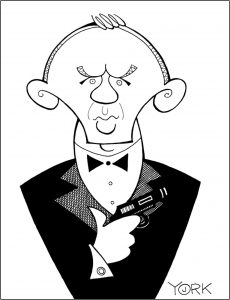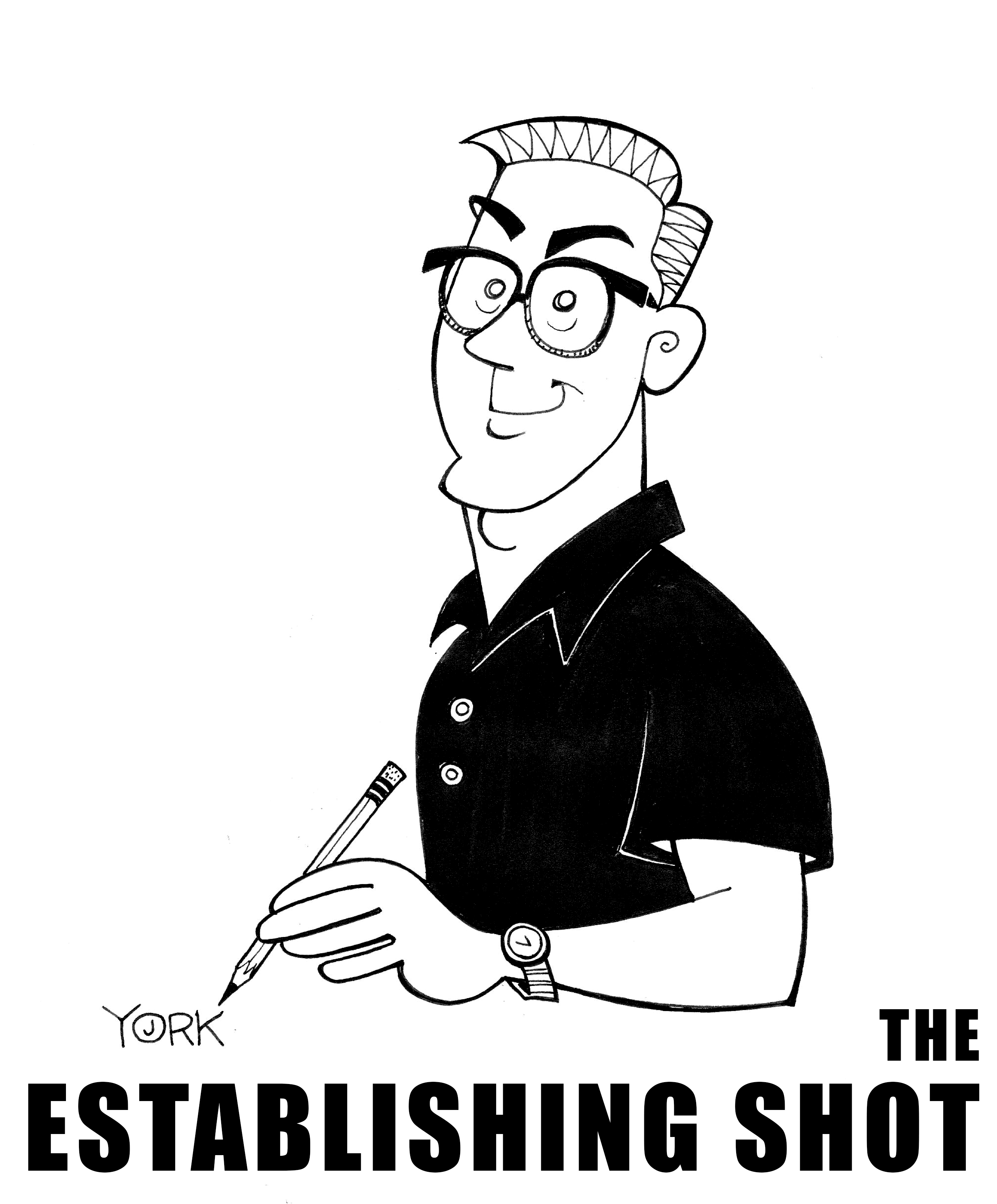
Original caricature by Jeff York of Daniel Craig as James Bond 007. (copyright 2014)
For fans of the James Bond spy franchise, it’s always a matter of degrees. Where does everything in the oeuvre fit on the spectrum from serious to silly? Indeed, the Bond franchise has yielded both. Sean Connery played the part much more brutish than Roger Moore, who often breezed through his films as if he were Groucho Marx stepping outside the action and commenting on it. Then, there were the henchmen: they could be sinister like Red Grant in FROM RUSSIA WITH LOVE or buffoonish like Jaws was in THE SPY WHO LOVED ME. And the villain’s lairs could go from opulent (MOONRAKER) to utterly excessive. That ice hotel in DIE ANOTHER DAY still seems like a bridge too far, even for escapist fare like Bond.
And as we come to the 27th big screen production for 007, which happens to be Daniel Craig’s fifth and final appearance in the role, his send-off stands as quite possibly the most serious of any Bond film to date. Its narrative, tone, and overall feeling have genuine weight, even gravitas. That’s not to say it isn’t entertaining, as it certainly is, but no other Bond feature feels quite as heavy for a number of reasons. And while NO TIME TO DIE may not be quite as top tier as the absolute best in the 50 + years of Bond on the big screen, this film, directed by Cary Joji Fukunaga, and written by Neal Purvis, Robert Wade, Fukunaga, and Phoebe Waller-Bridge, is terrific.
Daniel Craig has been credited with bringing many things to the franchise: toughness, modernity, and a more three-dimensional take on the character. Craig’s Bond was a spy who actually felt pain in his mind, body, and soul, unlike so many others who seemed utterly unflappable. And in NO TIME TO DIE, Craig makes even more of all those Bond attributes, bonding with those onscreen in deeper ways than before, and with the audience watching him in the dark too.
Bond’s story here starts with him being reluctantly pulled back into the game after retiring to play “house” in Italy with Madeleine (Lea Seydoux), his love interest from 2015’s SPECTRE. Their lives are threatened in the first minutes of the movie, and to add insult to some injuries, Bond thinks Madeleine may have betrayed him to Spectre. In the film’s first set-piece, they’re chased by Spectre henchmen all over a quaint Italian village and the scene is an absolute doozie. It’s not only superbly filmed and edited, with action that’s easy to follow, but it plays believably. That’s really Craig doing most of the huffing and puffing and driving, and, at the end of it all, there is a moment that is startlingly fresh and real. And it captures the essence of this new film perfectly.
The moment comes when Bond, who has been driving Madeleine in his souped-up car left from a previous mission, stops the car. He’s already used the car’s gadgets to dispatch a number of pursuers, but others have surrounded the vehicle and it looks like curtains for our lovers inside the vehicle. The Spectre baddies start firing their guns on the car’s bulletproof glass and it gets crispier with each volley. For a few moments, Bond does nothing, watching the destruction of his car, contemplating his predicament. You can see in Craig’s eyes that Bond is considering letting these killers put an end to all of his pain, once and for all. He rallies of course, but for a few seconds, Bond sits there wondering if it’s all been worth it. The scene is a stunt-filled show-stopper, but additionally, it is a key beat in the plot that sets up Bond’s inner conflict throughout this adventure.
A James Bond film with gravitas? Indeed. It’s startling. Additionally, the film plays so believably on other key measures as well. The bureaucracy of MI-6 becomes a plot point, the villain’s plan seems quite viable this time, especially considering our current pandemic state, and Bond’s blithe quipping are kept to a minimum. He’s still a clever, pithy character, but there’s only one groaner of a pun that, mercifully, Craig throws away. I wonder if some of that is due to the influence of bringing in Waller-Bridge (FLEABAG, KILLING EVE) to polish the script. There’s plenty of wit in the proceedings, but nothing corny or stale.
You can also recognize Waller-Bridge’s influence on the female characters on display. There are four major women’s roles this go-round (five if you include a female child), and they all get substantial screen time. Seydoux’s Madeleine is as well-rounded and complex as she was before. Leshana Lynch is a stand-out as Bond’s brave and brazen fellow agent Nomi. Naomi Harris’ Moneypenny isn’t just office window dressing but a vital contributor to the course of the mission. And Ana de Armas is marvelous in a brief but crucial role as an American agent who reveals as many complexities of character as her gown reveals leg. (I dare say, it is quite a dress.)
The men on Bond’s side acquit themselves nicely too. Ralph Fiennes could do his company man M in his sleep, and Ben Whishaw’s Q never becomes a cartoonish wonk the way Desmond Llewellyn’s did in his later Bond appearances. Rory Kinnear shines too as an MI-6 aide, and any film with Jeffrey Wright in it, here reprising his role as CIA agent Felix Leiter, is better for it.
Where the film falters some is in regarding its villains. Christoph Waltz is scarily evil in his return as the incarcerated Blofeld, but he’s treated as if he’s morphed into Hannibal Lecter. Rami Malek doesn’t have a ton of screen time as the main villain Safin, but he’s serious and somber and scary, but did he need the maimed skin and Dr. No garb? And unfortunately, Safin’s given an underground lair on an island that should have stopped after the AUSTIN POWERS movies mercilessly ragged on such a cliched and ridiculous trope.
Still, quibbles aside, including a theme song and score that are good but not great, this is not only a strong film but a fitting swan song for Craig. He made Bond newly fascinating; more serious, vulnerable, and less sexist – a true rival to Connery as the best 007. He made three terrific films as Bond too that will stand the test of time: CASINO ROYALE, SKYFALL, and now, this one. NO TIME TO DIE is exciting, fun, and produced beautifully, one of the year’s best tent-poles. But what you’ll remember most is how much heart Craig puts into it. And yours might just ache considerably after the film ends.







